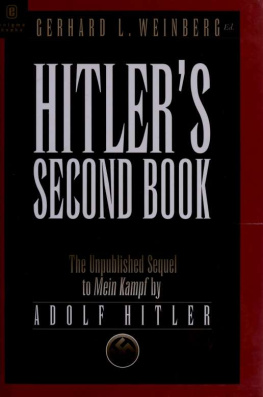Enigma Books
Also published by Enigma Books
Hitlers Table Talk: 19411944
In Stalins Secret Service
Hitler and Mussolini: The Secret Meetings
The Jews in Fascist Italy: A History
The Man Behind the Rosenbergs
Roosevelt and Hopkins: An Intimate History
Diary 19371943 (Galeazzo Ciano)
Secret Affairs: FDR, Cordell Hull, and Sumner Welles
Hitler and His Generals: Military Conferences 19421945
Stalin and the Jews: The Red Book
The Secret Front: Nazi Political Espionage
Fighting the Nazis: French Intelligence and Counterintelligence
A Death in Washington: Walter G. Krivitsky and the Stalin Terror
The Battle of the Casbah: Terrorism and Counterterrorism in Algeria 19551957
Hitlers Second Book: The Unpublished Sequel to Mein Kampf
At Napoleons Side in Russia: The Classic Eyewitness Account
The Atlantic Wall: Hitlers Defenses for D-Day
Double Lives: Stalin, Willi Mnzenberg and the Seduction of the Intellectuals
France and the Nazi Threat: The Collapse of French Diplomacy 19321939
Mussolini: The Secrets of His Death
Mortal Crimes: Soviet Penetration of the Manhattan Project
Top Nazi: Karl WolffThe Man Between Hitler and Himmler
Empire on the Adriatic: Mussolinis Conquest of Yugoslavia
The Origins of the War of 1914 (3-volume set)
Hitlers Foreign Policy: 19331939The Road to World War II
The Origins of Fascist Ideology 19181925
Max Corvo: OSS Italy 19421945
Hitlers Contract: The Secret History of the Italian Edition of Mein Kampf
Secret Intelligence and the Holocaust
Israel at High Noon
Balkan Inferno: Betrayal, War, and Intervention, 19902005
Hollywoods Celebrity Gangster
Calculated Risk
The Murder of Maxim Gorky
The Kravchenko Case
The Mafia and the Allies
Hitlers Gift to France
The Nazi Party 19191945: A Complete History
Santi Corvaja
Hitler and Mussolini
The Secret Meetings
Translation and Foreword
by Robert L. Miller
Enigma Books
All rights reserved under International and Pan-American
Copyright Conventions.
Published by Enigma Books
New York
www.enigmabooks.com
Copyright 2008 by Enigma Books
First Paperback Revised Edition
Original Italian title: Mussolini nella tana del lupo
English translation by Robert L. Miller
No part of this publication may be reproduced, stored in a retrieval system, or transmitted, in any form or by any means, electronic, mechanical, photocopying, recording, or otherwise without permission of Enigma Books.
ISBN 978-0-98249-116-4
Library of Congress Cataloging-in-Publication Data
Available on request.
Table of Contents
A dolf Hitler and Benito Mussolini have been dead for over half a century and Japanese militarism has vanished from Asia since 1945 but the grim reminder of the living hell their Axis alliance represented for the people of Europe and indeed the world is still very much with us. The fact that they did not succeed is certainly our good fortune. Today, many decades after those shattering events, we are entitled to ask the question as to how and why the two dictators came together as they did and what their Fascist, Nazi and Imperial Japanese Axis was really all about.
Few political associations have had as disastrous an outcome as the one forged between Hitler and Mussolini. The Axis alliance in defeat ultimately managed to destroy its founders, their regimes, and the lives of millions of people in Europe, Africa, and Asia in the process. Yet, the deeper motivations that were the root cause of the alliance between Germany and Italy, with the added ingredient of Imperial Japan and the political and personal relationship that existed between Hitler and Mussolini, remains unclear and in many aspects even mysterious to this day.
Veteran Italian journalist, the late Santi Corvaja, filled an important gap in examining the events that brought about the fateful bonding of the two dictators and history of the meetings between the German and Italian leaders. This book is in fact the only complete chronicle as recorded by many observers and participants to all the seventeen meetings between Hitler and Mussolini. It places the conferences in their proper context, within the history of the broader political and personal relationship that existed between the two Axis allies. Among the many studies of the German-Italian alliance most of them tend to concentrate on specific periods, such as the standard works by Elizabeth Wiskemann, The Rome-Berlin Axis 19341945, and F. W. Deakin, The Brutal Friendship, limited to the final years from 1942 to 1945, to cite two of the most remarkable early reference works on the subject. Other more specialized books like Renzo De Felices Mussolini e Hitler I Rapporti Segreti 19221933 focus on the early period preceding the first face to face meeting. None of these works,
In presenting Hitler and Mussolini: The Secret Meetings, a few important issues that characterized the relations between Fascist Italy and Nazi Germany that go beyond the actual meetings between the two leaders deserve some discussion. For example: the relationship between their respective ideologies, Fascism and National Socialism; the significance of racism and anti-Semitism and its consequences; the essential role played by the world economic crisis of the 1930s leading to the Axis alliance; the war and the ultimate defeat of the Axis; and, finally, the personal and political relationship between the two dictators.
From the beginning, Fascists and Nazis repeatedly referred to their ideological affinities in official and unofficial communications. Hitler frequently paid homage to Fascism and the political persona of Mussolini, in whom he recognized his model as founder of the Fascist Party.to it, come what may, and Hitler was determined to do exactly the same seeing in the Fascist take over of the state a model he wanted to follow.
As the Fascist party veered to the extreme right after its electoral debacle of 1919, it adopted many of the positions of the predominantly middle-class Nationalist movement. Most Nationalist writers, such as Enrico Corradini, Alfredo Oriani, and the poet, Gabriele DAnnunzio, articulated the main political themes and attitudes that were to become the new dogma of Italian Fascism. Territorial claims against almost all of Italys neighbors were justified by the presence of significant Italian-speaking minorities: in Nice, Corsica, Tunisia, and along the Dalmatian coast and some of the Greek islands. The Treaty of Versailles of 1919 was viewed by the Nationalists as a sell out and a mutilated victory by the politicians who bowed to the great powers, namely England and France. The Nationalists also provided a powerful rhetoric, filled with lyrical references to the past glory of the Roman Empirea strong Italy must rightfully return to the lands conquered by the Roman Legions through imperial and colonial expansion within the Mediterranean and deep into Africa. This was only a reclaiming of what rightfully belonged to the Roman Empire that Fascist Italy intended to reclaim. Fascism in its second authoritarian phase that begins after the assassination of Socialist deputy Giacomo Matteotti in 1924 relied heavily on the police and the OVRA as it established strict law and order within Italy in a bitter struggle to suppress Socialism, Communism, Liberal democracy and any other alien influence, occasionally taking on a xenophobic and vaguely anti-Semitic flavor. The conservative and well organized middle class Nationalist movement and the Fascist Party would formally merge in 1924 into the PNFPartito Nazionale Fascista.
Next page














